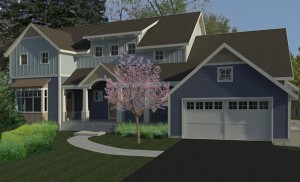City incentive to bring 40% permit fee rebate
Preliminary Platinum LEED Rating
HERS Rating 40 (without PV)
Built to exceed Energy Star standards
21st Century Craftsman

“When we first started thinking about building our own home we knew we wanted one that would be energy efficient, healthy and representative of our family. We appreciate the style and local history of Craftsman architecture, but also wanted modern touches like an open-concept floor plan, in‐home technology and environmentally friendly building techniques and products,” said future owners Aaron and Jenny Stash.
Enter Architect Michael Kollman and his company SmartHaus who will begin construction on the home in Northbrook this spring. The custom, high-performance home is being designed and built to a LEED for Homes Platinum rating, the highest rating given to homes when certified by the US Green Building Council. LEED homes are built to be energy efficient and environmentally responsible and are rated for health, comfort and durability by a rigorous third party review process.

Why LEED for Homes?
“Why not? The long term benefits of building an energy efficient, healthy home far outweigh the incremental upfront costs. Studies suggest the initial construction cost of a home represents only 11% of a building’s total cost of ownership. Beyond financials, the benefits to our family and our community are immense. If that weren’t enough, the Village of Northbrook’s forward-thinking Green Building Initiative ordinance made the decision even easier.”
Homes that are LEED-certified measure a home’s performance based on eight categories: site selection, water efficiency, materials & resources, energy & atmosphere, indoor environmental quality, location & linkages, awareness & education, and innovation. A home that achieves LEED certification has been designed to maximize fresh air indoors, minimizing exposure to airborne toxins and pollutants, and in our case uses 45% less energy– than a home built to the International Energy Code Council’s (IECC) 2012 code in Illinois.
Economic, Social and Environmental Benefits
Less energy use means lower utility bills every month throughout the life of the house. Beyond energy efficiency, achieving LEED certification is a mark of leadership in green homebuilding, clearly differentiating a home as among the best in the country. LEED is like the nutrition label that demonstrates in measurable terms how a home incorporates efficient features, healthy indoor air quality and environmentally friendly construction practices with the added assurance that the final product has been third party-verified and performance tested.
“This is our future. The jump in technology and science over the last few years has been incredible. We can accurately predict how a home will heat and cool and maintain healthy indoor environments utilizing very simple concepts and applications. Homes can be fine tuned to take advantage of site features, owner’s preferences and budget. We can design and build homes today that can produce as much energy as they need to operate. That goes for deep energy retrofits on existing homes as well. There are financial incentives in place to help defray some of the costs of emerging technologies as well.” Architect Michael Kollman says.
The house has been laid out to take maximum advantage of both passive and active solar energy, natural ventilation, low impact and recyclable materials, high efficiency lighting and controls, in a structure that is very simple and economical to build. “Every material and system has been studied in terms of its environmental impact and life cycle costs.”
The envelope of the house is designed to require a minimum amount of energy in order to live and use the home based on the lifestyle of the occupants.
The home will have an innovative HVAC system that has been recently developed by engineers from the University of Illinois which uses considerably less energy than a conventional heating and cooling system and provides extremely high indoor air quality utilizing a CERV (conditioned energy recovery ventilation system) combined with a cost effective installation.
The home has been reviewed by and has been given a preliminary Platinum rating, if you are interested in learning more about the SmartHaus, check it out at www.smarthaus.org
